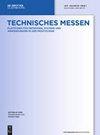Qualification and optimisation of a gas mixing apparatus for complex trace gas mixtures
IF 0.7
4区 工程技术
Q4 INSTRUMENTS & INSTRUMENTATION
引用次数: 0
Abstract
Abstract A gas mixing apparatus (GMA) can provide well-defined gas mixtures, which are necessary to calibrate gas sensors for quantitative measurements. This article presents a novel modular GMA and especially the representative measurements carried out to qualify and quantify its performance. New methods were developed to optimise the GMA’s settling speed and to enable self-monitoring. The GMA is able to provide up to 14 individual test gases, each in a large concentration range from sub-parts-per-billion to hundreds of parts-per-millions. Additionally, the relative humidity can be set. The system is able to provide stable gas mixtures in approximately 6 min. The entire control software is realised in Python, which determines the control setpoints of all relevant system components based on the concentration input of the user. A major focus was placed on minimising the time of a gas mixture exchange to confirm design and additional software optimisation. Also, a number of techniques are shown for the analytical quantification of the system, including analysis of thermal desorption tubes by an accredited laboratory, showing maximal contaminations of e.g. only 4.18 ppb ethanol. Finally, self-monitoring of the system using photoionization detectors (PID) is demonstrated as an addition to flow readback for internal leakage detection.用于复杂微量气体混合物的气体混合装置的鉴定和优化
摘要气体混合装置(GMA)可以提供定义良好的气体混合物,这是校准气体传感器进行定量测量所必需的。本文介绍了一种新型模块化GMA,特别是进行了具有代表性的测量,以确定和量化其性能。开发了新的方法来优化GMA的沉降速度并实现自我监测。GMA能够提供多达14种单独的测试气体,每种气体的浓度范围从十亿分之一到百万分之数百。另外,还可以设置相对湿度。该系统能够在大约6分钟内提供稳定的气体混合物。整个控制软件是用Python实现的,它根据用户的浓度输入确定所有相关系统组件的控制设定值。主要的重点是尽量减少气体混合物交换的时间,以确认设计和额外的软件优化。此外,还展示了许多用于系统分析定量的技术,包括由认可的实验室对热脱附管的分析,显示最大污染例如仅为4.18 ppb乙醇。最后,使用光电离检测器(PID)对系统进行自我监控,作为内部泄漏检测的流量回读的补充。
本文章由计算机程序翻译,如有差异,请以英文原文为准。
求助全文
约1分钟内获得全文
求助全文
来源期刊

Tm-Technisches Messen
工程技术-仪器仪表
CiteScore
1.70
自引率
20.00%
发文量
105
审稿时长
6-12 weeks
期刊介绍:
The journal promotes dialogue between the developers of application-oriented sensors, measurement systems, and measurement methods and the manufacturers and measurement technologists who use them.
Topics
The manufacture and characteristics of new sensors for measurement technology in the industrial sector
New measurement methods
Hardware and software based processing and analysis of measurement signals to obtain measurement values
The outcomes of employing new measurement systems and methods.
 求助内容:
求助内容: 应助结果提醒方式:
应助结果提醒方式:


